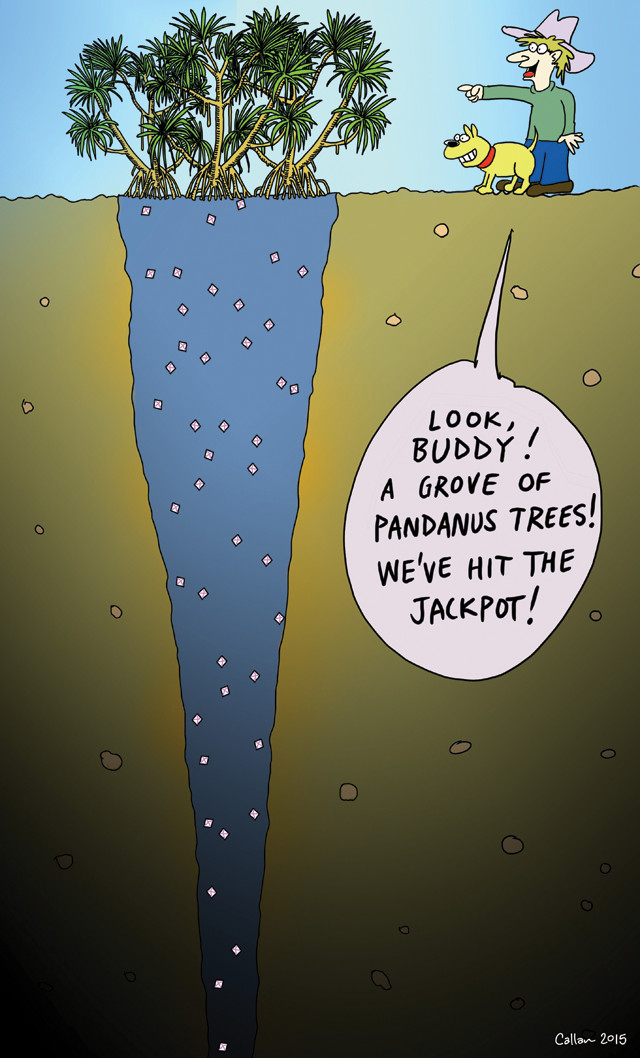
by Mary Caperton Morton Thursday, August 6, 2015

Credit: ©Callan Bentley.
Editor’s note: This story was updated on Oct. 9, 2015, to fix an error in the size of the kimberlite pipe. West Africa is famous for diamonds, brought up from the depths of Earth’s mantle eons ago during explosive volcanic eruptions. On the surface, the eroded remains of these eruptions, known as kimberlite pipes, are infamously hard to find under the thick jungles of Guinea, Sierra Leone and Liberia, and only a few of the deep, narrow pipes contain profitable diamonds. Now, a researcher has identified an unusual feature that might point the way toward such pipes, and possibly revolutionize the search for diamond-rich deposits: a tall, thorny palm-like plant that seems to only grow atop kimberlites.
Roughly 6,000 kimberlite pipes have been discovered worldwide, including in Africa, Siberia and North America, but fewer than 10 percent are rich enough in diamonds to be mined economically, says Stephen Haggerty, a geologist at Florida International University in Miami and author of the new study published in Economic Geology.
The main difficulty in locating the pipes comes from the lush vegetation that covers this part of Africa, Haggerty says. “The bush is absolutely impenetrable,” he says. One plant in particular gives explorers a lot of trouble: a palm-like member of the Pandanus genus with menacing spines and stilted roots that can grow up to 10 meters high.
The genus is found throughout Africa, the Pacific islands and Australia, but this particular species, named Pandanus candelabrum, seems to have an affinity for the unique soil chemistry of kimberlite pipes, which are rich in magnesium, potassium and phosphorus. “Any horticulturist will tell you: That combination makes for good fertilizer. No wonder they’re so menacing: These plants are growing like weeds in a natural habitat [primed] for enhanced growth,” Haggerty says.
Plants have been used to find minerals since medieval times. A pink-flowering plant in Scandinavia called Lychnis alpina and a white-flowering shrub in central Africa called Haumaniastrum katangense are both adapted to the unique soil chemistry of copper-rich deposits, for example.
“Plants aren’t always a perfect indicator for finding minerals, but sometimes they can help narrow down the search,” says Steven Shirey, a geologist with the Carnegie Institution for Science in Washington, D.C., who was not involved in the new research. “If this plant is really as choosy as [Haggerty] says it is, it could transform how prospectors look for kimberlite pipes,” Shirey says. “Of course, just because it helps find kimberlites doesn’t mean it helps to find [diamond-bearing] kimberlites.”
Haggerty’s botanical observation comes on the heels of his 2013 discovery of a new diamond-bearing kimberlite pipe in Liberia. The soil near the surface of the pipe, which measures 500 meters long by 50 meters wide at the surface, has already yielded four diamonds, including two 20-carat gems. And the development of this pipe could be a boon to Liberia, an impoverished country recently rocked by an Ebola epidemic, says Haggerty, who is also the chief exploration officer for the Youssef Diamond Mining Company, which has holdings in Liberia.
While mapping and exploring the terrain around the new pipe, Haggerty noticed the boundaries of the P. candelabrum grove somewhat aligned with the footprint of the kimberlite pipe. Then he found a similar pattern at three other previously known diamond-bearing pipes in the region, all with lush thickets of P. candelabrum growing over the deposits. So far, the particular species has not been found growing elsewhere in the region, Haggerty says.
The next steps will be to study the kimberlite soil to determine which qualities could be attracting P. candelabrum, as well as to study the nutrient exchange cycles between the plant and the magnesium-rich soil. Haggerty is also hoping to identify the spectral signatures of the plant in hopes of developing a method to spot groves of the plant from satellites. Spectral techniques have proved useful elsewhere — for example for identifying pockets of coveted hardwoods in the Amazon rainforest, Haggerty says.
However, the small surface area of kimberlite pipes and the small footprint of the P. candelabrum groves may make identification by satellite difficult, Shirey says. “Resolution will be the challenge, since kimberlite pipes are shaped like carrots: narrow and deep,” he says. But, he adds, “satellite resolution keeps getting better and better, so it might prove possible.”
© 2008-2021. All rights reserved. Any copying, redistribution or retransmission of any of the contents of this service without the expressed written permission of the American Geosciences Institute is expressly prohibited. Click here for all copyright requests.